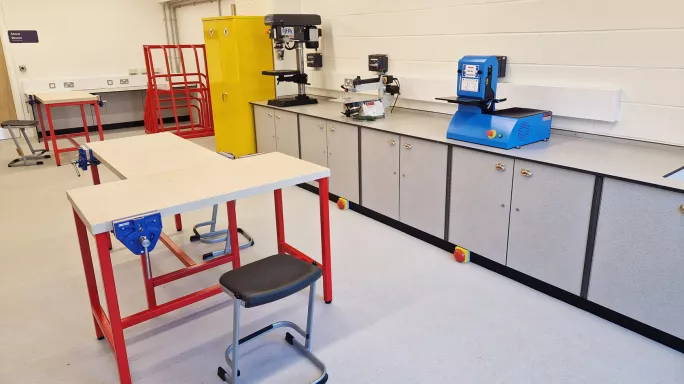- Home
- Analysis
- Specialist Sector
- Inside the school leading a ‘revolution in youth justice’
Inside the school leading a ‘revolution in youth justice’

This article was originally published on 17 May 2024
“There are strong links between education and offending,” wrote Charlie Taylor in his 2016 review of the Youth Justice system.
Mr Taylor, who went on to become chief inspector of prisons in 2020, noted that half of 15- to 17-year-olds entering young offender institutions (YOIs) had the literacy or numeracy levels expected of 7- to 11-year-olds. About 40 per cent of young people surveyed in under-18 YOIs had not been to school since they were 14.
Given this, he criticised the failure of the youth justice system to provide any meaningful education for young offenders, which might prevent reoffending and provide them with opportunities when released.
“If children who offend are to become successful and law-abiding adults, the focus must be on improving their welfare, health and education - their life prospects - rather than simply imposing punishment,” he wrote.
To achieve this, he proposed flipping the model of custody for young offenders so that education is at the heart of their custodial experience.
“Children who are incarcerated must receive the highest-quality education from outstanding professionals to repair the damage caused by a lack of engagement and patchy attendance,” he wrote.
“In order that education is truly placed at the heart of youth custody, I believe that the government must re-conceive youth prisons as schools. I propose the creation of secure schools.”
A secure school
Fast-forward eight years and that proposal has come to pass with the opening of the first secure school, Oasis Restore.
Based two miles outside of Rochester, the school is situated on the former site of the Medway Secure Training Centre, which was closed in March 2020 after a series of damning Ofsted reviews.
However, while geographically the same, the facilities, focus and ethos of the school that 49 children aged 12-19 will be sent to from the start of June, are worlds apart.
“This is a revolution in youth justice,” says Oasis founder Steve Chalke during a pre-opening visit attended by Tes.
Consistency and commitment
He explains that YOIs have been too focused on the punishment of children and that by acting as another location that “wounds” a young person - who will likely have already experienced trauma in their life that led them to commit crimes - they do nothing to alter that behaviour for the future.
“We can’t use punishment - we can’t hurt someone to heal them,” he says.
It’s a point that Cara Beckett, director of learning and enrichment at Oasis Restore, underlines by relaying a statistic from a Ministry of Justice report in 2022, which reported that 69 per cent of children and young people released from custody reoffend within 12 months of release.
At Oasis Secure, therefore, the focus is based entirely on the notion of “healing” young people, through a combination of what the Taylor review called for - health, welfare and education - underpinned by secure and meaningful relationships with staff at the site, Chalke says.

“It’s all about relationships, about showing these young people we will be there for them, time and again, and that consistency and trust will build over time,” Chalke says.
Staff at the site know that this will not be easy and they will spend a lot of time not trusting the adults they encounter, he says: “We know they won’t trust us when they arrive, but we will win that trust through love and through being there time after time.”
Meaningful contact time
To help build those relationships, children who, in the past, would have spent large portions of the day being locked up, will instead be engaging in a raft of activities with each other and staff at the site. Activities will be based on four themes: reflection, movement, creation and learning.
“We want to give them 14 hours a day of meaningful contact time,” Beckett says.
Those hours will consist of activities including therapy and healthcare, but chiefly education, focusing on literacy, numeracy, PSHE, sports and vocational activities.
While most of these lessons will take place on site, there will be scope for some children to attend lessons remotely, particularly for English Baccalaureate subjects.
There is also a well-stocked library with everything from non-fiction, such as Grit and 101 Essays That Will Change the Way You Think, to Roald Dahl classics.
For vocational courses, there is a culinary suite, two music rooms with recording booths, design and technology rooms kitted out with numerous tools, including circular saws, and areas to practise skills such as painting and bricklaying.
At the weekends, other activities, such as music studies, journalling and transition preparation for those either leaving the facility or going to a mainstream prison, will take place.
Staff safety
Alongside this, there is time for cooking and talking about their day in their shared dining spaces in one of the three houses (not wings) where children will live - called Mountain, River and Forest - each of which features large French doors that can be opened, and which look out over the centre of the site.

Meanwhile, inside their rooms (not cells) are touchscreen TVs built into the walls, en-suite showers, and windows that let in plenty of light. Couple this with the pastel shades and warm colours that adorn various walls around the site and it’s easy to feel you are on a university campus, not in a prison.

But the reality is, Chalke says, that children sent here will have committed “dangerous and violent offences” and ended up at the last stop on the line. “There are no exclusions from here,” he says.
Given this, the safety of staff is high on the agenda. The ratio of adults to children per session will be three adults to five children and all staff are trained in de-escalation techniques.
Many items are secured to the floor or weighed down with sand (such as the chairs) so they can’t be thrown, while security cameras are dotted around the site.
However, staff say the reality is that children are more of a risk when they are bored than when they are engaged in activities, so having a packed agenda is, in its own way, part of the safety provision.
Avoiding a criminal label
For teachers, coming to work at the site is, of course, very different from a normal school - as is made clear by the fact that they are not employed on the teacher terms and conditions, and are instead contracted to work either 35- or 39-hour weeks in accordance with the school’s own policies.
While there are no term times, the site does follow a rhythm that broadly mimics that of schools by having between five- and seven-week terms, followed by two weeks of “mid-terms”, when lessons stop and activities such as sports or performances take place and family visits occur.
Keeping the site feeling as much like a school as possible is something that its director of care and wellbeing, Dr Celia Sadie, who has previously worked as a clinical psychologist with children in custody, has written is key to the site’s ethos.
“There is a real risk inherent in children entering a secure setting. It is a ‘social transition’, of sorts, and is potentially a concretisation of the labelling of a child as a criminal,” she wrote.
“This is why it is so important Oasis Restore is a school, not a prison. In a school, you can learn and develop. In a prison, well...it’s a lot harder.”
No key, quiet doors
As part of this work, one building on the site has been designated as a transition space, where children will learn to adapt to their new environment rather than simply being placed straight in with other children and expected to integrate.

“This transition will take up to 12 weeks and ensure that children can adapt and do not feel the need to ‘fight’ to feel secure,” says Dr Sadie during the visit.
Even the ominous sounds of slamming doors and jangling keys, synonymous with prisons, are not to be found at Oasis Restore, where doors have been designed to close softly, and staff open and lock doors electronically.
“We had someone come to work here from a prison and they said the sound of doors slamming all day long and keys banging can be really traumatic, so we have removed that from the site,” Beckett says.
The ethos of Oasis Restore being a school and not feeling like a prison extends to accountability, as it will be inspected and registered as a school and a secure children’s home by Ofsted, and as a health provision by the Care Quality Commission.
This also means that the school can refuse to take children sent by the courts, on safeguarding grounds, which, given that girls and boys aged between 12 and 19 could be on site together, is something staff say will need to be given appropriate consideration.
A long wait
Given how much of a departure all this is from the existing YOI model, it is no surprise when Chalke says he “did a little dance” after he got the call to tell him Oasis had won the contract to create the first secure school.
That call, though, came five years ago, in early 2019, and at the time it was expected that the first children would be on site by autumn 2020 - with the cost of getting it ready set at £4.9 million.
However, a National Audit Office report in 2022 reported that costs rose to £36.5 million owing to “significant design revisions after due diligence” - which was why it has taken so long to open and accept its first intake of children.
Despite these delays, the government has remained committed to the project, with Dominic Raab, then justice minister, saying in August 2022 that Oasis Restore would be a “revolutionary change” in the youth justice system.
“[It will give offenders] the tailored curriculum and mental health support they need to turn away from crime and get into training and work,” he said. “It’s the right thing to do for them and the public, driving down reoffending and making our streets safer.”
Relentless love
Nevertheless, while all those involved in the planning and preparation for the new site are confident that this new model can deliver, they acknowledge it is a pilot project and that, while similar models exist elsewhere, such as in Scandinavia, it is untested in England.
Chalke, though, is unwavering in his belief that it will work and can become a model that could, in time, be replicated around the country and usher in a new era of youth justice.
“The model here is about love. I was talking to some people from the House of Lords and I said this, and they said, ‘Yes, but what is your strategy, there must be more to it?’ And I said, ‘Yes there is, it will be relentless love’.”
For the latest education news and analysis delivered directly to your inbox every weekday morning, sign up to the Tes Daily newsletter



